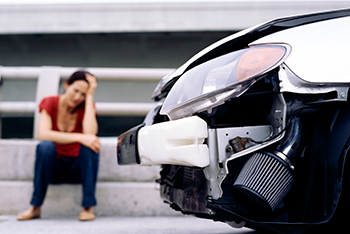 July 2, 2014 – As lawyers, we are all too painfully aware that we don’t have all of the answers, whatever clients may expect. Hopefully we do know the right questions to ask. In the case of underinsured motorist coverage, the questions are quite straightforward. Why do I need underinsured motorist coverage, and how much should I carry? The answers, as usual, are a bit more complicated.
July 2, 2014 – As lawyers, we are all too painfully aware that we don’t have all of the answers, whatever clients may expect. Hopefully we do know the right questions to ask. In the case of underinsured motorist coverage, the questions are quite straightforward. Why do I need underinsured motorist coverage, and how much should I carry? The answers, as usual, are a bit more complicated.
Underinsured motorist coverage protects individuals injured in a car accident if the other driver does not have enough coverage to pay for the damages. Historically, if damages were more than the other driver’s insurance coverage, the individual’s own underinsured motorist coverage would pay the difference between your damages and the amount received from the other driver.
In recent years, however, the rules governing underinsured motorist coverage have changed significantly. Lawyers and clients should understand these rules before the need to rely upon underinsured motorist coverage arises.
That Was Then, This Is Now
In all too many cases, people carry very substantial liability limits and far lower underinsured motorist limits. In effect, those people are providing more protection for others than they are for themselves and their family.
Wisconsin has adopted mandatory automobile liability insurance. That means there are probably fewer uninsured motorists and more motorists who are insured, but carry minimum liability limits. In Wisconsin, those limits are $25,000 per person and $50,000 per accident. Given the current costs of medical care, it is not unusual to see medical bills substantially exceed those minimum limits for a person with a significant injury.
Underinsured motorist coverage is typically an inexpensive way to guard against the situation where the other driver’s insurance is far less than what is needed to compensate someone who is seriously injured for their damages.
Those damages include not only medical expenses and loss of income, but the overall impact of a serious accident on the injured person’s quality of life.
In all too many cases, people carry very substantial liability limits and far lower underinsured motorist limits. In effect, those people are providing more protection for others than they are for themselves and their family.
 Mike Riley (U.W. 1973), an attorney at Axley Brynelson LLP, Madison, practices in the areas of personal injury, insurance, mediation and arbitration. He has lectured and written extensively on matters relating to the settlement and trial of personal injury claims.
Mike Riley (U.W. 1973), an attorney at Axley Brynelson LLP, Madison, practices in the areas of personal injury, insurance, mediation and arbitration. He has lectured and written extensively on matters relating to the settlement and trial of personal injury claims.
That makes very little sense, particularly because the cost of underinsured motorist coverage is substantially less than the cost of liability coverage.
In other cases, people who should have underinsured motorist coverage do not. The companies are required to make a one-time offer of underinsured motorist coverage. The coverage is not mandatory and the minimum the company needs to offer is $50,000 per person and $100,000 per accident. That amount is totally inadequate.
Unfortunately, our experience suggests that neither insurance companies nor many of their agents have made their insureds aware of the importance of underinsured motorist coverage, or its limitations. In many instances, our clients tell us that had anyone explained the need for the coverage and the amounts they should carry, they would gladly have purchased adequate limits. That information is of little help once an accident has occurred and the reality dawns that they do not have the coverage they need.
The problem is compounded by the fact that the amount of underinsured motorist coverage shown on the declarations page of the policy does not mean what most clients believe it means.
What You See Is Not What You Get
Clients, and many lawyers, assume that the limits of underinsured motorist coverage shown on the policy’s declaration page are the amount that they could receive if they were injured by someone whose liability limits were not enough to pay for the damages they caused. That is almost never true.
First, an underinsured motorist is defined in virtually all policies as someone whose liability coverage limits are less than your underinsured motorist coverage limits.
Have more questions about underinsured motorist coverage?
See the comprehensive discussion in Arnold P. Anderson, Wisconsin Insurance Law (State Bar of Wisconsin PINNACLE 6th ed. 2010 & Supp.) (ch. 4, Underinsured Motorist Insurance), or the outline in Wisconsin Judicial Benchbook vol. II: Civil (State Bar of Wisconsin PINNACLE 4th ed. 2011 & Supp.) (ch. CV-48, Insurance Questions).
If the person who injured you had a $50,000/$100,000 liability limits and you had underinsured motorist coverage in the same amount, you would receive nothing.
This is true at any level of coverage. Your underinsured motorist limits must be higher than the other driver’s liability limits in order for you to recover underinsured motorist coverage benefits.
That comes as a shock to many clients. What is more shocking is that they will almost never be entitled to receive what they thought they were entitled to from their underinsured motorist coverage. Wisconsin has adopted rules that permit insurers to subtract from the underinsured motorist limits amounts paid by the other driver’s insurance company, as well as amounts from other sources.
Most clients believe that their underinsured motorist limits will be paid over and above what is paid by the driver who caused the accident. In fact, the amount of underinsured motorist coverage shown on the declarations page is misleading, because that amount will virtually never be paid.
Example
A simple example may be helpful. Let’s say that you have purchased underinsured motorist coverage in the amount of $100,000 per person and $300,000 per accident.
If one person is injured in the accident and recovers $50,000 from the other driver’s liability carrier, the maximum amount the insured will recover from his underinsured motorist coverage is $50,000, not $100,000.
If one or more people were injured and the liability carrier for the responsible motorist paid their full policy limit of $100,000 per accident, then the underinsured motorist policy limit would be reduced to $200,000. In addition to payments to the insurer for the other driver, there may be other amounts deducted which would reduce the underinsured motorist limit further.
Conclusion
Given the relatively nominal cost and the increased scope of the risk, both lawyers and clients should check their policies and confirm that they have an adequate amount of underinsured motorist coverage. Lawyers may also want to alert their clients to the importance of purchasing sufficient coverage.
Our experience suggests that neither insurance companies nor agents have made this a priority. Lawyers are in a position to remedy the information gap. If the need arises, your client will certainly thank you.
